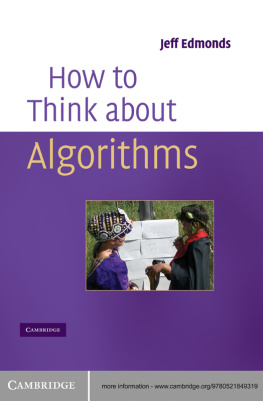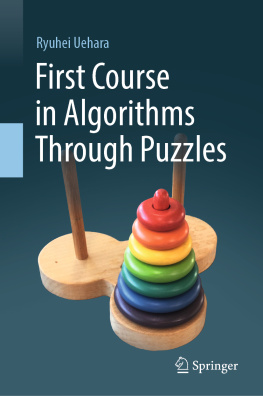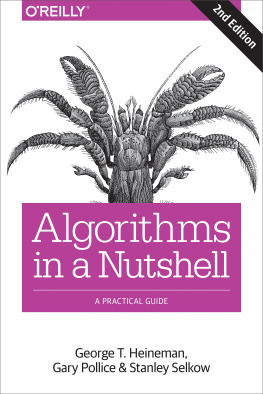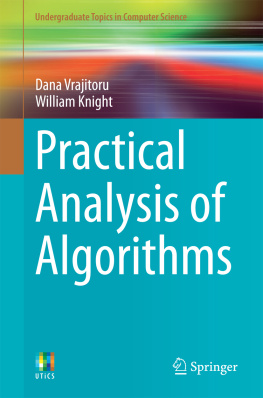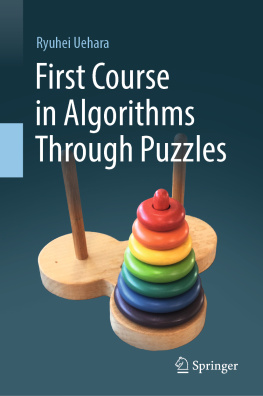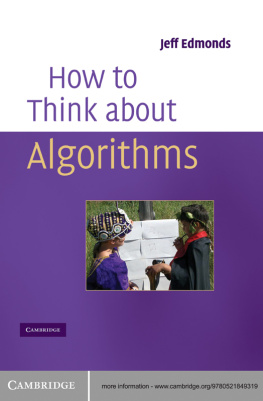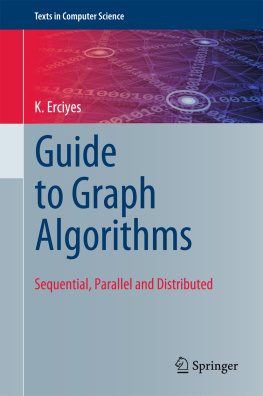HOW TO THINK ABOUT ALGORITHMS
There are many algorithm texts that provide lots of well-polished code and proofs of correctness. Instead, this one presents insights, notations, and analogies to help the novice describe and think about algorithms like an expert. It is a bit like a carpenter studying hammers instead of houses. Jeff Edmonds provides both the big picture and easy step-by-step methods for developing algorithms, while avoiding the common pitfalls. Paradigms such as loop invariants and recursion help to unify a huge range of algorithms into a few meta-algorithms. Part of the goal is to teach students to think abstractly. Without getting bogged down in formal proofs, the book fosters deeper understanding so that how and why each algorithm works is transparent. These insights are presented in a slow and clear manner accessible to second- or third-year students of computer science, preparing them to find on their own innovative ways to solve problems.
Abstraction is when you translate the equations, the rules, and the underlying essences of the problem not only into a language that can be communicated to your friend standing with you on a streetcar, but also into a form that can percolate down and dwell in your subconscious. Because, remember, it is your subconscious that makes the miraculous leaps of inspiration, not your plodding perspiration and not your cocky logic. And remember, unlike you, your subconscious does not understand Java code.
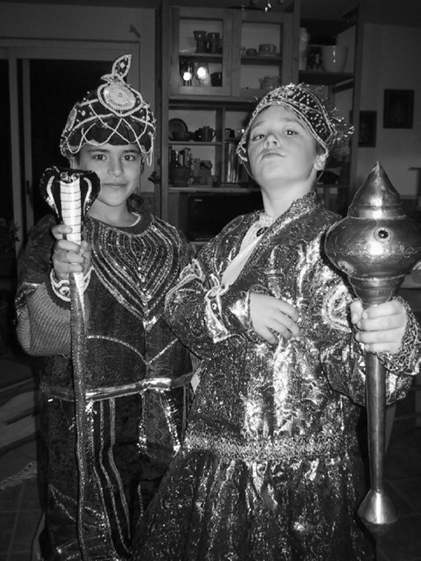
HOW TO THINK ABOUT ALGORITHMS
JEFF EDMONDS
York University

CAMBRIDGE UNIVERSITY PRESS
Cambridge, New York, Melbourne, Madrid, Cape Town, Singapore, Sao Paulo, Delhi
Cambridge University Press
32 Avenue of the Americas, New York, NY 10013-2473, USA
www.cambridge.org
Information on this title: www.cambridge.org/9780521614108
Jeff Edmonds 2008
This publication is in copyright. Subject to statutory exception and to the provisions of relevant collective licensing agreements, no reproduction of any part may take place without the written permission of Cambridge University Press.
First published 2008
Printed in the United States of America
A catalog record for this publication is available from the British Library.
Library of Congress Cataloging in Publication data
Edmonds, Jeff, 1963
How to think about algorithms / Jeff Edmonds.
p. cm.
Includes index.
ISBN 978-0-521-84931-9 (hardback) ISBN 978-0-521-61410-8 (pbk.)
1. Algorithms Study and teaching. 2. Loops (Group theory) Study and teaching. 3. Invariants Study and teaching. 4. Recursion theory Study and teaching. I. Title.
QA9.58.E36 2008
518.1dc22 2008001238
ISBN 978-0-521-84931-9 hardback
ISBN 978-0-521-61410-8 paperback
Cambridge University Press has no responsibility for the persistence or accuracy of URLs for external or third-party Internet Web sites referred to in this publication and does not guarantee that any content on such Web sites is, or will remain, accurate or appropriate.

Dedicated to my father, Jack, and to my sons, Joshua and Micah.
May the love and the mathematics continue to flow between the generations.
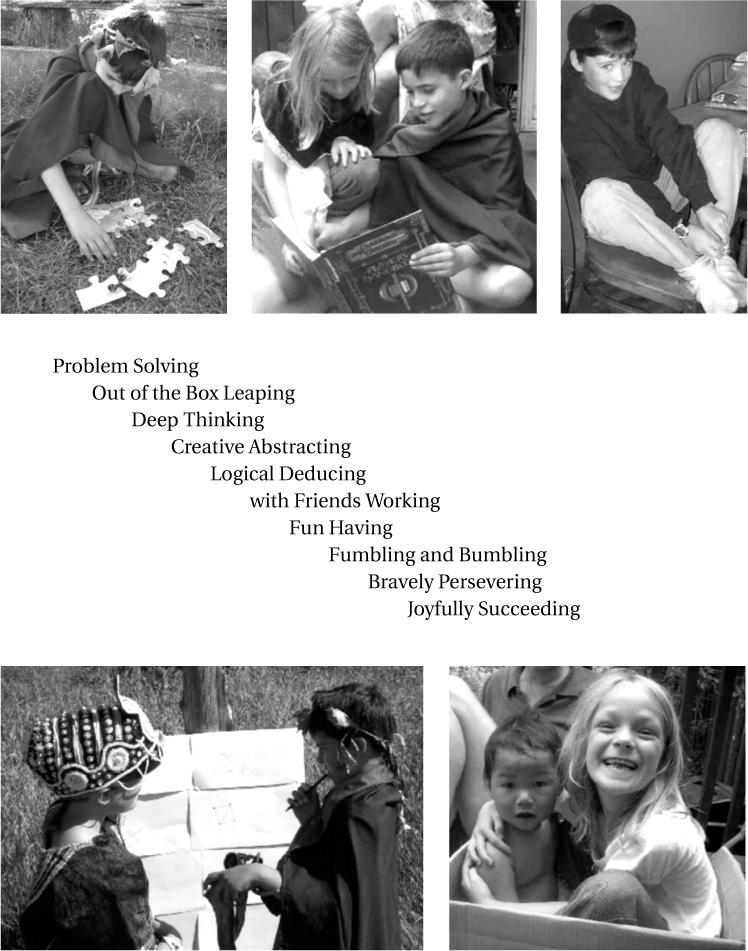
PREFACE
To the Educator and the Student
This book is designed to be used in a twelve-week, third-year algorithms course. The goal is to teach students to think abstractly about algorithms and about the key algorithmic techniques used to develop them.
Meta-Algorithms: Students must learn so many algorithms that they are sometimes overwhelmed. In order to facilitate their understanding, most textbooks cover the standard themes of iterative algorithms, recursion, greedy algorithms, and dynamic programming. Generally, however, when it comes to presenting the algorithms themselves and their proofs of correctness, the concepts are hidden within optimized code and slick proofs. One goal of this book is to present a uniform and clean way of thinking about algorithms. We do this by focusing on the structure and proof of correctness of iterative and recursive meta-algorithms, and within these the greedy and dynamic programming meta-algorithms. By learning these and their proofs of correctness, most actual algorithms can be easily understood. The challenge is that thinking about meta-algorithms requires a great deal of abstract thinking.
Abstract Thinking: Students are very good at learning how to apply a concrete code to a concrete input instance. They tend, however, to find it difficult to think abstractly about the algorithms. I maintain that the more abstractions a person has from which to view the problem, the deeper his understanding of it will be, the more tools he will have at his disposal, and the better prepared he will be to design his own innovative ways to solve new problems. Hence, I present a number of different notations, analogies, and paradigms within which to develop and to think about algorithms.

Way of Thinking: People who develop algorithms have various ways of thinking and intuition that tend not to get taught. The assumption, I suppose, is that these cannot be taught but must be figured out on ones own. This text attempts to teach students to think like a designer of algorithms.
Not a Reference Book: My intention is not to teach a specific selection of algorithms for specific purposes. Hence, the book is not organized according to the application of the algorithms, but according to the techniques and abstractions used to develop them.
Developing Algorithms: The goal is not to present completed algorithms in a nice clean package, but to go slowly through every step of the development. Many false starts have been added. The hope is that this will help students learn to develop algorithms on their own. The difference is a bit like the difference between studying carpentry by looking at houses and by looking at hammers.
Proof of Correctness: Our philosophy is not to follow an algorithm with a formal proof that it is correct. Instead, this text is about learning how to think about, develop, and describe algorithms in such way that their correctness is transparent.
Big Picture vs. Small Steps: For each topic, I attempt both to give the big picture and to break it down into easily understood steps.
Level of Presentation: This material is difficult. There is no getting around that. I have tried to figure out where confusion may arise and to cover these points in more detail. I try to balance the succinct clarity that comes with mathematical formalism against the personified analogies and metaphors that help to provide both intuition and humor.
Point Form: The text is organized into blocks, each containing a title and a single thought. Hopefully, this will make the text easier to lecture and study from.
Prerequisites: The text assumes that the students have completed a first-year programming course and have a general mathematical maturity. The Appendix (Part Four) covers much of the mathematics that will be needed.
Next page
